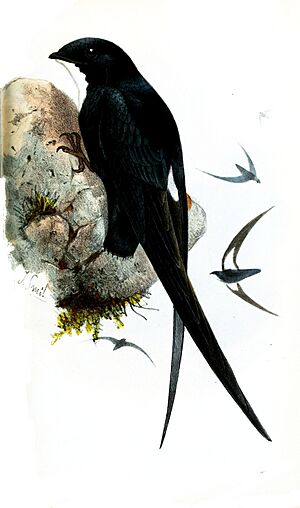Philippine spinetail facts for kids
Quick facts for kids Philippine spinetail |
|
|---|---|
| Conservation status | |
| Scientific classification | |
| Genus: |
Mearnsia
|
| Species: |
picina
|
The Philippine spinetail (Mearnsia picina) is a cool bird that's part of the swift family. Swifts are known for being super fast flyers! This special bird lives only in the Philippines, mainly on the islands of Mindanao and Visayas. It likes to live in warm, wet forests in low-lying areas. Sadly, it's becoming quite rare because its home is disappearing.
What Does the Philippine Spinetail Look Like?
This bird is a medium-sized swift with a short tail. It's mostly black, but it has clear white patches on its throat and under its wings. Its wings have a unique shape, almost like a "cut-out" near its body, and the tips are pointed and curve backward.
Its tail looks square, and it has tiny spines that are hard to see. You can tell it apart from other swifts in the Philippines because of the white marks under its wings. We don't know much about what its voice sounds like!
The Philippine spinetail has a cream-colored throat, cheeks, and belly. This helps tell it apart from a similar bird, the Southern silvery kingfisher, which has bluish-white parts.
Where Does the Philippine Spinetail Live?
This swift seems to prefer living near forested streams that are below 1,000 meters (about 3,300 feet) high. It can even live in forests that have been partly cut down or near streams within coconut farms, as long as there's still some forest nearby.
Why is the Philippine Spinetail in Danger?
The International Union for Conservation of Nature (IUCN) says this bird is "near threatened". This means it could become endangered if we don't protect it.
The biggest danger to the Philippine spinetail is habitat loss. Its forest homes are being cleared away for many reasons. These include cutting down trees for wood (logging), turning forests into farms, and digging for minerals (mining). Since this bird relies on lowland forests, it's very sensitive to losing its home.



